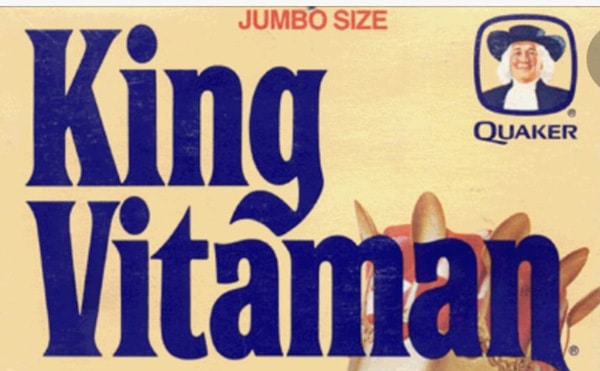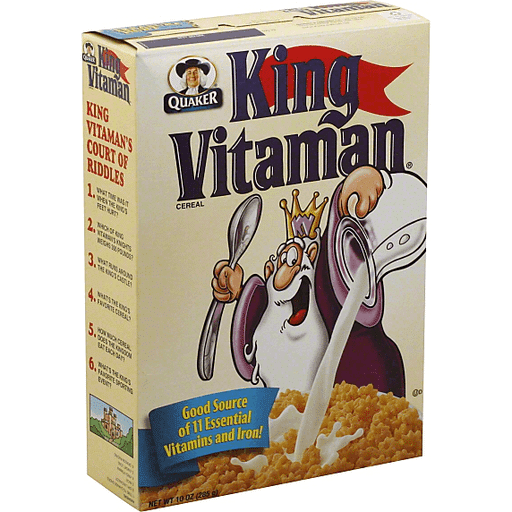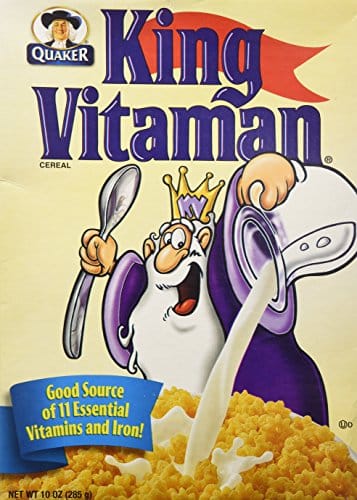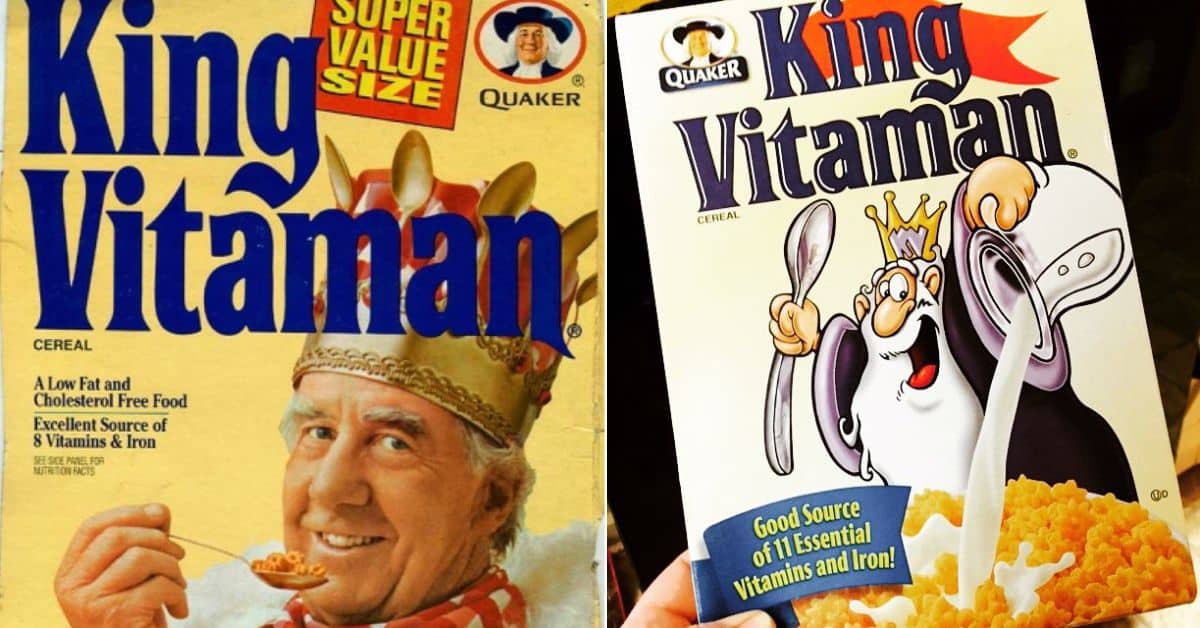King Vitaman Cereal
Many people are not aware that Quaker Oats has created a variety of different cereal products over the years. These cereals were often intended to be sold toward the healthy breakfast market, just like their oat products. One of the common features of most of Quaker’s products in the cereal market was a high vitamin content and a focus on reduced sugar content.
King Vitaman cereal was discontinued in 2019, and many people have requested that it be brought back to market again. Many people remember eating this cereal as part of their parent-approved breakfast during childhood and would still happily purchase it if it was offered at stores in their area.
Please leave a review or any memories of this snack in the comments at the bottom of this page. Thank you!
History
King Vitaman cereal was first sold in 1968 by Quaker Oats. This was a period when easy breakfast items flourished in the US due to an increasing number of households where both parents worked. Moms who would have stayed at home all day cooking meals for their kids could no longer do so, but they still wanted their children to be able to eat a balanced breakfast before they got on the bus to go to school.
There were many different kinds of cereal during the 60s that were marketed as healthy and ideal for feeding to children. King Vitaman was marketed in a more general way in an effort to target both adults and children. There were various mascots over the years that this cereal was on the market, these cartoon characters being thought of by most cereal brands as the perfect way to snag the attention of US children.
Jaw Ward created the first mascot for the cereal. He was well-known by this time for being the creator of Rocky and Bullwinkle. King Vitaman and his nights, Sir Laffitup and Sir Cravenleigh were present in all of these commercials, often fighting against the Blue Baron and the Not-So-Bright-Night.
There were lots of cereal brands in the 60s and 70s that had their own associated comics, and the effort to create this kind of outreach for King Vitaman is clear in the early marketing materials. Having an entire storyboard about the characters selling King Vitaman cereal to kids was nothing out of the ordinary, although it seems like a lot of effort to go to these days just to market a food product.
The original slogans for the cereal were often grabbed from the dialogue of the characters. Lines like, “Not me, you dingaling, the cereal!” and “Have breakfast with the king” were pulled from the chatter between King Vitaman and his often bumbling knights.
Between 1971 and 1977, the animated characters were traded out for depictions that were photographic. George Mann was used for the King Vitaman ad campaign that was done with photographic art. Over the years, various actors were used to depict the fictional king. In 2000, Quaker Oats returned the advertising to an illustrated character again.
The King was also intended to be wise and serious and have the answers to everything in the commercials for this product. This tied in well with the message that cereal brands wanted to send that eating cereal made you smarter and more prepared to tackle your day.
Many people who enjoyed the cereal while it was on the market state that it is reminiscent of Cap’N Crunch. One person stated that the cereal was a lot like other “sugar bombs” of the era, but without quite the same amount of sugar included. This made it a little healthier and a lot more palatable for those who didn’t want to start each and every morning out with the equivalent of a few candy bars’ worth of sugar in their cereal bowl.
Many people also noted that the porous nature of the cereal clusters meant that you had to eat King Vitaman cereal pretty rapidly to maintain the satisfying crunchiness that made it so beloved. However, most people don’t linger when eating their cereal, so this was probably not much of a hindrance for most people who loved the cereal.
People who grew up trusting the King of King Vitaman cereal to reassure them that their breakfast choices were excellent often mention that it was a lot more fun when food products were marketed to kids. This cereal product, like so many others which include sugar in their recipes, were required to cease marketing exclusively to children when it was discovered that sugar was actually quite bad for your well-being in the late 1970s. By the end of the 80s, cereals and many other products were no longer allowed to be marketed directly to children in the same way that they were in the 60s and early 70s.
Children of the baby boomer generation actually express nostalgia about the concept of food products that were made just for them. The commercials for kids’ food were fun, full of life, and colorful. They also spawned lots of great toys and fun ways to send in box tops to get cool items back from the companies that sold the products in question.
Ultimately, there are many cereals that are actually much healthier to eat these days than King Vitaman cereal. Despite the product boasting about the included minerals and vitamins, the amount of sugar present in the recipe is still more than what most parents will happily allow their kids to eat. The cereal market has changed rapidly over the last ten years, and reduced sales of many classic brands have led to them being discontinued for good.
Today, Quaker Oats sells all of their oat products like instant oatmeal and traditional one-minute oats, and they also offer Quaker Simply Granola and Quaker Oatmeal Squares in the cereal space. These are still cereals that are offered to the health-conscious market. Perhaps Quaker believed that King Vitaman cereal was too similar to their granola products to bother to sell both items at the same time.
King Vitaman cereal is unlikely to enjoy a comeback in the future, despite fans of the cereal loudly clamoring for its return. Quaker knows that they sell far more product in the truly healthy market space, and their limited number of cereal products indicates that they are unlikely to continue to expand their cereal selections in the future.
Marketing
Beyond the mascots that were so beloved for this cereal, Quaker also made sure that kids got to have fun with their cereal. There were treasure hunts and mazes on the back of the boxes and for many years, you would be able to dig a toy out of the middle of the box. Things like a racing coach were included in boxes to help motivate kids to ask for the cereal at the store.
Box tops were commonly sent in to get prizes during the 70s and 80s, and many kids were able to secure things like an electric firetruck this way. Larger toys and games were almost always linked with cereal marketing from the late 60s to the early 90s, and most people remember sending box tops away for at least one item during their childhood.
Lots of the boxes of cereal that were on store shelves during the early years of George Mann’s reign as King Vitaman had a punch-out or cut-out mask on the back for kids to play with. Many children who said their moms didn’t allow them to eat name-brand cereals were grateful that King Vitaman still offered these little kid-friendly touches despite being considered “healthy” for kids.
The success of King Vitaman’s marketing for so many years was firmly centered around the fact that this was a healthy choice for parents and for kids alike. So many cereals were marketed at kids as being fun and exciting without concerns about them being truly healthy. Lots of kids were forced to eat far more boring cereals that were not advertised to them at all due to their parents being concerned that the cereals for kids were too sugary.
Quaker did a great job of walking the line between selling fun and kid-friendly cereal and appealing to the adult desire to feed kids better meals even if they had to eat food products that came out of a box. The transition period from stay-at-home moms to moms who had to work outside the home all day was one that made many parents worried about their children. Smart cereal companies knew that they needed to deliver products that mom and dad could approve of to help soften the blow of these major changes.
Logo

Ingredients
The recipe for this cereal is actually quite simple:
- Corn
- Flour
- Sugar
- Whole grain oat flour
- Salt
- Coconut oil
- Brown sugar
- Sodium ascorbate
- Vitamin E acetate
- Niacinamide
- Zinc oxide
- Yellow 6
- Vitamin B12
- Vitamin D3
- Thiamin mononitrate
- Pyridoxine hydrocholoride
- Folic acid
- riboflavin
Nutrition
| Serving Size: | 31g | % Daily Value * |
| Amount Per Serving | ||
| Calories | 118 | |
| Total Fat | 1.1g | 1% |
| Saturated Fat | 0.5g | 2% |
| Sodium 256mg 11% | 256mg | 11% |
| Total Carbohydrate | 26g | 9% |
| Dietary Fiber | 1.1g | 4% |
| Sugar | 6.3g | |
| Protein | 2g | 4% |
| Vitamin D | 0mcg | 0% |
| Calcium | 3.1mg | 0% |
| Iron | 9mg | 50% |
| Potassium | 83mg | 2% |
- * The % Daily Value (DV) tells you how much a nutrient in a serving of food contribute to a daily diet. 2000 calories a day is used for general nutrition advice.
Pictures


Ads
One of the classic ads for the cereal from its early days:
Another classic cartoon ad:
An ad with George Mann in it:
FAQ
Why did they discontinue King Vitaman Cereal?
King Vitaman Cereal was discontinued due to declining sales and changes in consumer preferences.

My name is Brianna and I love writing on all topics. Candy history fascinates me and I am passionate about sharing my love of this topic with everyone else!
Please leave a review or any memories of this snack in the comments below. Thank you!
Click here for a full A-Z list of Snacks and Candy
